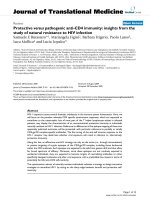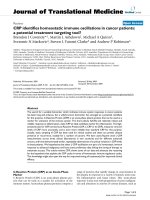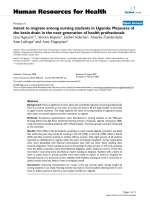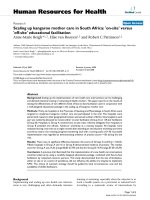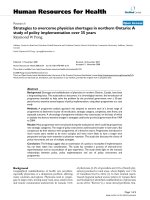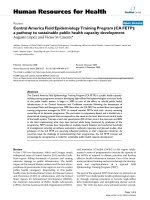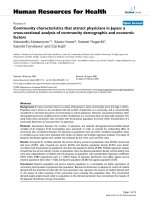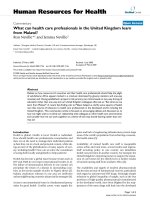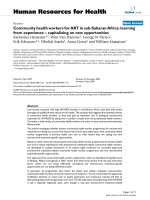báo cáo sinh học:"Strategies to overcome physician shortages in northern Ontario: A study of policy implementation over 35 years Raymond W Pong" pdf
Bạn đang xem bản rút gọn của tài liệu. Xem và tải ngay bản đầy đủ của tài liệu tại đây (255.33 KB, 9 trang )
BioMed Central
Page 1 of 9
(page number not for citation purposes)
Human Resources for Health
Open Access
Research
Strategies to overcome physician shortages in northern Ontario: A
study of policy implementation over 35 years
Raymond W Pong
Address: Centre for Rural and Northern Health Research and Northern Ontario School of Medicine, Laurentian University, Sudbury, Ontario,
Canada
Email: Raymond W Pong -
Abstract
Background: Shortages and maldistibution of physicians in northern Ontario, Canada, have been
a long-standing issue. This study seeks to document, in a chronological manner, the introduction of
programmes intended to help solve the problem by the provincial government over a 35-year
period and to examine several aspects of policy implementation, using these programmes as a case
study.
Methods: A programme analysis approach was adopted to examine each of a broad range of
programmes to determine its year of introduction, strategic category, complexity, time frame, and
expected outcome. A chronology of programme initiation was constructed, on the basis of which
an analysis was done to examine changes in strategies used by the provincial government from 1969
to 2004.
Results: Many programmes were introduced during the study period, which could be grouped into
nine strategic categories. The range of policy instruments used became broader in later years. But
conspicuous by their absence were programmes of a directive nature. Programmes introduced in
more recent years tended to be more complex and were more likely to have a longer time
perspective and pay more attention to physician retention. The study also discusses the choice of
policy instruments and use of multiple strategies.
Conclusion: The findings suggest that an examination of a policy is incomplete if implementation
has not been taken into consideration. The study has revealed a process of trial-and-error
experimentation and an accumulation of past experience. The study sheds light on the intricate
relationships between policy, policy implementation and use of policy instruments and
programmes.
Background
Geographical maldistribution of health care providers,
especially physicians, is a ubiquitous problem, affecting
many countries and regions. Physicians tend to congre-
gate in larger cities, leaving many rural areas, small towns
and remote communities underserved. In Canada, 9.4%
of physicians (2.4% of specialists and 16% of family phy-
sicians) practised in rural areas, where slightly over 21%
of Canadians lived in 2004 [1]. In their seminal report,
Toward integrated medical resource policies for Canada, Barer
and Stoddard [2] identified maldistribution of physicians
as one of five "first tier" (i.e. most critical) problems. Sim-
Published: 11 November 2008
Human Resources for Health 2008, 6:24 doi:10.1186/1478-4491-6-24
Received: 16 November 2007
Accepted: 11 November 2008
This article is available from: />© 2008 Pong; licensee BioMed Central Ltd.
This is an Open Access article distributed under the terms of the Creative Commons Attribution License ( />),
which permits unrestricted use, distribution, and reproduction in any medium, provided the original work is properly cited.
Human Resources for Health 2008, 6:24 />Page 2 of 9
(page number not for citation purposes)
ilarly, the Commission on the Future of Health Care in
Canada [3] pointed out that "(a)ccess to physicians and
specialists varies significantly across the country and some
communities do not have access to the most basic health
care services because they lack the necessary health care
providers" (p. 162).
Severe and persistent maldistribution of physicians is
clearly an unacceptable situation, especially in Canada,
where there is a national Medicare system, with two of its
five basic principles being "accessibility" and "universal-
ity". Many strategies have been used to effect a more equi-
table distribution of physicians. Knowing what influences
physicians to work or not to work in rural areas helps us
understand why certain strategies are adopted. These
include rural background [4-6], family factors including
spousal influence [7,8], medical education [9-12], medi-
cal practice [13,14], and income [13]. Goertzen [15] has
identified four sets of factors that are believed to encour-
age rural practice: personal interests and background,
appropriate medical training, community attributes and
working conditions.
This study has two objectives. First, it documents, in a
chronological manner, the introduction of programmes
designed to alleviate physician shortages in northern
Ontario over a 35-year period from 1969 to 2004 and
examines changes in the use of policy instruments. This is
done by charting the introduction of new programmes,
including those subsumed under the Underserviced Area
Program (UAP). A related objective is to examine several
aspects of policy implementation, using these pro-
grammes as a case study. These two objectives are comple-
mentary.
This study is predicated on the belief that government-ini-
tiated programmes are manifestations of public policies
which, quite often, remain implicit or are couched in
broad generalities. Whereas policies are statements of ide-
ologies, political agenda, values or government priorities,
programmes are means to translate policies into desired
outcomes. Between policies and programmes one may
also find implicit policy instruments, which are broad
strategies used by policy-makers to guide or design pro-
grammes. Thus, the nature and characteristics of a pro-
gramme reflect the policy behind it and the preferred
policy instrument. By examining how programmes are
introduced, modified or terminated, one could deduce
shifting policy perspectives on an issue and the strategies
adopted.
Research on policy implementation has traditionally
focused on the approaches used, such as "top-down" or
"bottom-up", and complexities and challenges facing
implementation [16-18]. Moving beyond these typical
concerns, this study seeks to examine what policy instru-
ments were used and how they changed over time. It has
been said that studies of policy instruments have contrib-
uted to a better understanding of Canadian public policy
[19]. This study hopes to further this area of research. But,
instead of focusing on a single programme, it looks at how
a broad array of programmes has been introduced over a
35-year period. Sabatier [18] has criticized American pol-
icy implementation research for using a short time frame.
A longer time frame is also needed in policy implementa-
tion studies in Canada because, as Fooks [20] has
observed, "(t)he Canadian health policy culture is not an
environment in which rapid change is easily achieved" (p.
131).
This study pays special attention to several aspects of pol-
icy implementation. Public policy-making has been seen
by some as a rational approach and described by others as
a process of "muddling through", involving small, incre-
mental changes [21]. Policy implementation processes
may be similarly characterized, since policy formulation
and policy implementation often overlap [22]. This study
seeks to find out if policy implementation is a rational or
an incremental process. It also tries to understand why
some policy instruments were chosen, while others were
not.
The policy at issue is the Ontario government's stated
intention to ensure a sufficient physician supply to serve
the population in northern Ontario – a vast territory of
about 800,000 sq km with a widely scattered population
of about 800,000. It might not be a mere coincidence that
the UAP was established in 1969, the very same year when
the Ontario Health Insurance Plan (OHIP) – the provin-
cial Medicare programme – was introduced. OHIP was
intended to ensure universal access to needed medical and
hospital care for all Ontarians regardless of economic
means. But removal of financial barriers to health care is
meaningless if providers and services are not available or
are very difficult to access. Thus, as far back as 1969 (and
possibly earlier), the Ontario government saw shortages
of health care providers, especially physicians, in northern
Ontario as a problem that needed attention and interven-
tion.
While the magnitude of the problem may have changed,
the policy goal does not appear to have shifted since 1969.
This can be gleaned from various policy declarations over
the years contained in speeches given by premiers and
ministers of health and government press releases. For
instance, in announcing the development of programmes
to train family physicians in northern Ontario, a press
release from the Office of the Premier [23] in 1990 stated,
"A Northern Ontario residency training programme for
medical school graduates entering family practice was
Human Resources for Health 2008, 6:24 />Page 3 of 9
(page number not for citation purposes)
announced today by Premier David Peterson 'This new
programme promises to help solve the problem of recruit-
ment and retention of physicians in northern, rural and
remote communities,' said Mr. Peterson". In announcing
the Free Tuition Program in 2000, a ministry of health
news release remarked, "'This initiative will provide finan-
cial assistance to medical students and address the needs
of rural and northern communities,' (Minister) Witmer
said. 'We are working with doctors, medical students and
communities to ensure that all Ontarians have access to
physician services"' [24].
Lucas [25] examined the availability of physicians in
small, single-industry communities in Northern Ontario
in 1968, just one year before the launch of the UAP. Of the
240 communities examined, 176 (or 73%) were without
a doctor and another 23 with only one doctor. After stud-
ying the numbers of physicians in northern Ontario from
the 1950s to the 1980s, Anderson and Rosenberg [26]
concluded that the UAP had not improved the supply or
distribution of physicians in that region. However, a more
recent study [27] shows that northern Ontario had an
increase of 6.2 full-time-equivalent family physicians
(specialists not included) per 100 000 population
between 1993/1994 and 2001/2002, whereas all other
regions of the province experienced a negative growth.
However, it is not the intent of this study to assess the
impact of the UAP and other programmes, individually or
collectively.
Methods
Information about programmes to help overcome physi-
cian maldistribution, their characteristics and the years of
programme introduction was obtained from official doc-
uments, programme brochures, web sites and discussions
with government officials. A study by Tepper and associ-
ates [28] contains a similar list of programmes, which was
used to verify information accuracy.
Of all the programmes examined, the most important is
the UAP. Initiated in 1969, the UAP is one of the largest
and longest-lasting programmes of its kind in North
America. It is an interrelated set of programmes funded
and, in some cases, administered by the ministry of health
and designed to attract health care practitioners, including
physicians, to work in northern Ontario. It is the pro-
grammes subsumed under the UAP and other pro-
grammes with the same objective but not under the UAP
umbrella that are of interest to this study. Although the
UAP has expanded in more recent years to cover some
underserved communities in southern Ontario, the focus
of this study is on northern Ontario.
Several criteria were used to decide which programmes
were to be included in the study. Programmes must be
financially supported by the provincial government,
though not necessarily funded or administered by the
ministry of health. Federal government initiatives were
not included. Similarly, programmes belonging to non-
government agencies were excluded because the study is
primarily interested in public policy. Also not included
were "generic" strategies that did not specifically target
northern Ontario, such as Ontario medical school enrol-
ment expansion and fast-tracking of international medical
graduates into practice. They might have workforce impli-
cations for the north, but they were province-wide pro-
grammes and often had a marginal impact on northern
Ontario.
Some programmes have evolved over the years. For exam-
ple, the Northern Health Travel Grants Program has been
modified several times with respect to eligibility criteria
and subsidy level. The management of some locum ten-
ens programmes has shifted from the ministry of health to
other agencies. Such operational changes have been
ignored, as this study is about changes in policy instru-
ments used and not about programme administration.
The programmes included in this study can be analysed
not only in terms of the types of strategy used, but also in
terms of the time frame of expected outcomes, degree of
programme complexity and outcome objectives. The
methodology used is programme analysis: the nature of
each programme was examined to determine its strategic
category, time frame, and so on.
Policy researchers have suggested different ways to classify
policy instruments [29-31]. The strategies used to over-
come geographical maldistribution of physicians can also
be categorized in different ways. For instance, Crandall
and colleagues [32] have proposed a four-category classi-
fication: affinity, economic incentive, practice characteris-
tic and indenture models. Similarly, Barer and Wood [33]
have suggested four categories: regulatory/administrative,
educational, financial and laissez-faire strategies. But
these and similar classification schemes are too broad and
not sufficiently discriminating to allow differentiation
between programmes or detection of more subtle changes
in the use of policy tools. An in-depth examination of
changes in policy implementation requires a more elabo-
rate categorization system. Following an examination of
the objectives, programme guidelines and specifics of
each of the included programmes, the following types of
policy instrument were identified:
1. Financial incentives: Providing incentives to medical stu-
dents or physicians willing to work in northern Ontario.
2. Physician recruitment: "Marketing" northern Ontario to
physicians.
Human Resources for Health 2008, 6:24 />Page 4 of 9
(page number not for citation purposes)
3. Alternative providers: Using non-physician practitioners
such as nurse practitioners where physicians are not avail-
able.
4. Rural medical education/training: Training physicians in
rural or northern areas.
5. Medical practice support: Making northern practice less
onerous in order to enhance its attractiveness.
6. Service outreach: Bringing services to areas where they
are not locally available.
7. Patient travel assistance: Providing financial assistance to
patients who have to travel long distances to access medi-
cal care.
8. Telemedicine: Linking patients and physicians via tele-
communications technology.
9. Research: Using research to support rural health work-
force planning.
The next step was to sort each programme into one of the
nine categories. A chronology of programme initiation
was then constructed, based on the year in which a pro-
gramme was first introduced. Some programmes may
have a long gestation period. For instance, the establish-
ment of the Northern Ontario School of Medicine
(NOSM) was officially announced in 2001, but the first
cohort of students was not admitted until 2005. Typically,
the year when a new programme started operation was
chosen as the initiation year. In the case of the NOSM,
2002 was chosen because the Founding Dean was
appointed in that year.
Results
The analysis was conducted by examining changes in
strategies, time frame, complexity and expected outcome.
As Table 1 shows, over the years, many programmes were
introduced and different strategies employed. A list of all
programmes by policy instrument is shown in Additional
File 1.
In the first two-and-a-half decades, new programmes were
initiated at a relatively slow pace, at the rate of one or two
a year. The exception was 1969, which was not surprising
since the UAP was established in that year. There were
periods spanning two to four years during which no new
programmes were initiated. The speed of programme ini-
tiation picked up after 1995, sometimes with three to five
programmes introduced in a year.
Table 1: Programmes to address physician shortages in northern Ontario introduced by the Ontario government by policy instrument
type and year, 1969 – 2004
Financial
incentive
Physician
recruitment
Alternative
providers
Rural medical
education
Medical
practice
support
Service
outreach
Travel
assistance
Telehealth Research
1969 x x x x
1970 x
1972 x
1977 x
1978 x
1979 xx
1980
1982 x x x
1985 x
1991 x
1992 x x
1994 x x
1995 xx
1996 x x x
1997 xx
1998 xxx
1999 xxx
2000 xxx
2001 x
2002 xx x xx
2004 x
Note: Each cross represents a programme. Multiple crosses in a cell indicate several programmes belonging to the same policy instrument type
introduced in that year.
Human Resources for Health 2008, 6:24 />Page 5 of 9
(page number not for citation purposes)
From the beginning, a variety of strategies were employed.
In later years, the range of policy instruments used became
even broader. For example, three new programmes were
introduced in 2000, each representing a different policy
tool. But financial incentive programmes were clearly the
most often used. They came in different forms, ranging
from bursaries for medical students to alternative funding
schemes. Programmes to support medical practice, such
as locum tenens programmes and virtual libraries, were
also frequently used. So were physician recruitment pro-
grammes such as recruitment tours and the appointment
of community development officers whose main job was
to help northern communities find and keep doctors.
The first northern medical education initiative – the
Northwestern Ontario Medical Program – started fairly
early in 1972, though it was small in scale. The real invest-
ment in northern medical education occurred in 1991,
when two family medicine residency programmes were
established in Sudbury and Thunder Bay. The most signif-
icant initiative was the NOSM, the first medical school
built in Canada in over 30 years.
Although many policy tools were employed, conspicuous
by their absence were programmes of a directive nature,
directive in the sense that physicians are required to work
in northern or underserved communities for a certain
period as a condition for admission to medical school or
obtaining an OHIP billing number. Similarly, there were
no programmes that sought to address spousal or family
issues, which, as many studies have shown, are some of
the most important factors in determining where physi-
cians work.
Once introduced, a programme tended to persist. It might
be modified, enriched or rolled into a new or bigger pro-
gramme, but was rarely terminated. The few programmes
that were discontinued include the Medical/Dental Cent-
ers Programme funded by the Ministry of Northern Devel-
opment and Mines and the fee discounts measure, which
penalized new physicians who chose to practise in "over-
serviced" areas by getting lower OHIP fee payments.
The programmes can also be analysed in terms of com-
plexity in design and procedures. Some of the more recent
programmes are more "sophisticated" in the sense that
they tend to be more complex, more focused and better
calibrated. For example, early financial incentive pro-
grammes were fairly simple, compared to more recent
ones such as the Community Sponsored Contracts and
Globally Funded Group Practices. Similarly, in terms of
scale, complexity and ambition, the two family medicine
residency programmes established in 1991 cannot be
compared to the NOSM, which was inaugurated in 2005.
Another way to examine the programmes is in terms of
the time frame of outcomes. Some programmes were
designed to yield immediate results, while others were not
expected to have an impact until years later. There is also
the degree of outcome certainty. Some strategies or pro-
grammes are more "risky" in the sense that there is no cer-
tainty of tangible outcomes. For example, the Medical/
Dental Centers Program was intended to quickly attract
physicians and dentists by offering a "turnkey" facility at
little or no cost to a physician or dentist willing to estab-
lish practice in the north. On the other hand, the NOSM
can be seen as a long-term investment, since it will take
many years before a student completes medical education
and residency training and, even then, there is no guaran-
tee that the new physician will work in northern Ontario.
Similarly, the support of rural health workforce research is
a long-term strategy, since research typically does not
yield immediate results, but tends to focus on more com-
plex or fundamental issues and explore innovative solu-
tions. Programmes introduced in earlier years tended to
have short- or medium-term time frames, while many of
the programmes with a longer-term perspective were
introduced in the 1990s and 2000s.
Efforts to overcome physician shortages can be divided
into two major categories: recruitment and retention.
Whereas the former is an effort to get a doctor to set up
practice in a community, the latter is an attempt to keep
the doctor there as long as possible. Recruitment without
retention often results in a "revolving door" phenomenon
– physicians come and go. While government efforts have
focused mostly on recruitment, some programmes, such
as the locum tenens programmes and alternative funding
models, were designed with retention in mind. Overwork,
burnout and a feeling of isolation are some of the factors
leading to physicians' abandoning northern practice.
Locum tenens programmes, for example, were intended
to allow physicians in small communities to take time off
work for holidays or continuing medical education. Simi-
larly, by allowing physicians in remote places to keep up
with the latest developments in the field, the Northern
Ontario Virtual Library, which provided access to data-
bases, journals and books via the Internet, could be seen
as a means to reduce isolation. Programmes initiated in
earlier years focused mostly on recruitment, whereas
those intended to retain physicians came later. For
instance, although there were many incentive pro-
grammes, the earlier ones were mostly for enticing physi-
cians to work in the north by offering financial
inducement. More recent programmes were mostly in the
form of alternative payment schemes, which were
designed to allow small-town doctors to opt out of fee-
for-service payments, which tended to encourage doctors
to see as many patients as possible, often resulting in over-
work and burnout.
Human Resources for Health 2008, 6:24 />Page 6 of 9
(page number not for citation purposes)
There does not appear to be a strong connection between
provincial elections and programme initiation. During
the study period, provincial elections in Ontario were
held in 1971, 1975, 1977, 1981, 1985, 1987, 1990, 1995,
1999 and 2003. It is not apparent that many new pro-
grammes were introduced in election years as a way of gar-
nering electoral support for the governing party (though it
is possible that new initiatives were promised during elec-
tion campaigns). In fact, a few election years saw no intro-
duction of any new programme. There was a raft of new
programmes introduced in 1999, but this may have more
to do with the faster pace of programme initiation since
1996, as noted earlier, than with the provincial election.
There were several internal reviews of individual pro-
grammes, which resulted in some programme fine-tun-
ing. For instance, the Northern Health Travel Grants
Program was reviewed a couple of times and the Visiting
Specialist Clinics Program was reviewed in 1999. In addi-
tion, there was a major review of the entire UAP in the
early 1990s [34]. But it does not appear that the UAP was
substantially changed in the years following this review.
Another major review of the UAP took place in 2001–
2003. The uncharacteristic lack of new programmes in
2003 and 2004 could be due to a wait-and-see attitude
following the review.
Discussion
Many questions have emerged from the above analysis.
For instance, why were certain policy instruments used
and not others? Why were there changes over the years?
Changes over the years
The nature, or perceptions, of physician workforce issues
changed over time. In the mid-1960s, just before the UAP
debut, Canada was seen by the Royal Commission on
Health Services as having doctor shortages. By the late
1980s and early 1990s, there was a belief – at least among
governments – that Canada had a surfeit of physicians.
This resulted in a number of measures to control physi-
cian supply. But, by the late 1990s, the pendulum swung
back to the other side, as reflected by widespread concerns
about physician shortages. Thus, building a medical
school in the north would have been unthinkable in the
early 1990s when Canadian medical schools were told to
curtail enrolment. The mushrooming of new programmes
in the late 1990s and the early 2000s may reflect growing
unease about the need for physicians not just in the north,
but also in some southern Ontario cities.
The late adoption of technology-related strategies is
understandable. Telemedicine is a case in point. Although
some form of telemedicine has existed ever since Alexan-
der Graham Bell invented the telephone, its more wide-
spread adoption has occurred only in the last decade or
two when communications technologies have become
more sophisticated, reliable and affordable. Similarly, the
introduction of the Northern Ontario Virtual Library to
support clinicians in far-flung places would not have been
possible before the advent of the information technology
age.
It is also apparent that attempts were made in more recent
years to deal with fundamental issues and not just provide
symptomatic relief. As noted earlier, financial incentive
programmes in the early years were designed primarily to
recruit doctors to work in northern areas. More recent
incentive programmes began to address retention issues
by allowing rural physicians to opt out of fee-for-service
reimbursement. Similarly, the decision to build a new
medical school was probably made after the realization
that in the long run, the north needs to "grow" some of its
own doctors, instead of relying totally on imports.
Choice of policy instruments
Although many programmes were introduced over the
years, interestingly, there were no programmes of a direc-
tive nature. It has been said that public policies are what-
ever governments choose to do or not to do [35]. Thus, it
is important to know not just policy instruments that have
been adopted, but also those not pursued. However,
Brooks and Miljan [16] are right in pointing out that it
makes no sense to talk about policy when an issue has not
yet surfaced. "Once it has, however, inaction by policy-
makers becomes a deliberate policy choice" (p. 5).
The absence of programmes of a directive nature is not
because the issue and strategic alternatives have not sur-
faced. Some provinces, such as British Columbia [36],
adopted or attempted to adopt measures whereby the
issuance of physician billing numbers could be tied to
geographical locations of practice as a way to channel
physicians to underserved areas. In the mid-1990s, the
Ontario government introduced Bill 26, The Savings and
Restructuring Act, which contained provisions that allowed
the Minister of Health to decide which areas of the prov-
ince were "over-supplied" with physicians and to refuse
issuing OHIP billing numbers to new physicians wishing
to work in those areas. This was meant to direct new doc-
tors to "under-supplied" areas. But the proposed measure
was never implemented because of opposition by organ-
ized medicine, particularly the Professional Association of
Internes and Residents of Ontario (PAIRO). Instead,
PAIRO urged the use of alternative funding models and
direct contracts, which, according to one estimate, "will
generally entail a 20 per cent increase in pay" [37] (p. 41).
It seems that the government has heard such messages
loud and clear. This may also explain the discontinuation
of the fee discounts measures, first introduced in 1996.
Human Resources for Health 2008, 6:24 />Page 7 of 9
(page number not for citation purposes)
Thus, the absence of directive measures can be seen as a
deliberate choice of policy instrument.
The lack of programmes to address individual, spousal or
family concerns is understandable. There is very little gov-
ernments can do to alter lifestyle preferences, shape family
relationships or satisfy spouses' career aspirations. Public
policy may be too blunt an instrument to use for tackling
problems that are highly personal or idiosyncratic in
nature. This may be an area considered to be the realm of
private behaviours not suitable for government interven-
tion [31].
There were some travel-related programmes. This is not
surprising, since "rural" and "northern" in the Canadian
context typically imply vast territory and the concomitant
need to travel. Access to care means either bringing serv-
ices to people or people to services. The former include
such programmes as the Visiting Specialist Clinics Pro-
gram. An example of the latter is the Northern Health
Travel Grants Program, which provides subsidies to
patients who have to travel long distances to gain access to
medical care. Another form of travel is telehealth. As Pong
and Pitblado [38] have suggested, "telehealth can be seen
as a form of mobility, involving long-distance 'travelling'
by patients to see their physicians or vice versa by means
of telecommunications" (p. 109).
The creation of the Northern Health Human Resources
Research Unit (later renamed the Centre for Rural and
Northern Health Research) in 1992 indicates a realization
that policy and programme development should be evi-
dence-based. It is also possible that the increasing reliance
on the rural medical training strategy, including the build-
ing of a medical school in northern Ontario, has been
influenced, at least in part, by research. The last two dec-
ades have witnessed a growing body of literature on the
relationship between rural medical education and rural
medical practice [9,39-41]. Studies conducted in Canada
and elsewhere generally support the notion that doctors
with an extensive rural exposure are more likely to practise
in rural areas.
Use of multiple strategies
Overcoming physician maldstribution is not an easy task.
That several strategies were introduced at the outset sug-
gests an early awareness that the problem was complex
and could be dealt with only by using a variety of strate-
gies. It is not just the adoption of multiple strategies but
also the simultaneous use of different strategies that is
worth noting. The policy implementation process does
not appear to be sequential in the sense that a programme
or strategy became outdated and was replaced by a new
one. Instead, few programmes were ever terminated. Also,
some strategies were used over and over in the form of
programmes with different names but of a similar nature:
witness the number of locum tenens programmes and
alternative payment models. The use of multiple strategies
is especially evident in more recent years as many older
programmes were retained and new ones added.
It is not known why strategies and programmes were used
simultaneously. Could it be that once a programme has
been introduced, it creates a constituency that ensures its
continuation? Is it because the existence of many pro-
grammes gives the impression of government attention
and action? Or is it because policy-makers have seen the
need for a bundling of several policy instruments as a
response to complex problems? Apparently physician
maldistribution is not like a disease that can be cured, but
is more akin to a chronic condition that needs to be man-
aged. Extending the medical analogy further, one could
liken the use of multiple strategies to polypharmacy, with
the potential danger of drug interaction. Tepper and asso-
ciates [28] have made a similar diagnosis when they high-
light the use of many policy initiatives and point out that
"(t)he amount of overlap also raises the question as to
whether a more integrated approach to policy planning
would be helpful" (p. 33).
Limitations
This study has some limitations. First, it has treated every
programme or strategy as equal. This clearly is not true.
Some programmes are considerably more complex and
costly, and presumably have a greater impact, than others.
Second, the study has focused on the initiation of pro-
grammes and disregarded changes following programme
introduction. But such changes have tended to be admin-
istrative in nature and do not indicate strategic redirec-
tion. Third, this study has not included physician
workforce initiatives that do not have a specific northern
Ontario focus. Some of these "generic" measures, such as
expansion of medical school enrolment and allowing
more international medical graduates to practise, may
have a bigger impact on northern Ontario than some of
the northern-specific programmes. However, their effects
on the north have not been empirically determined or
documented to date.
Conclusion
This study has looked at a policy implementation process
that has spanned 35 years. Although the policy goal of
increasing physician supply and ensuring better distribu-
tion in northern Ontario has remained the same, the strat-
egies and programmes used to implement the policy have
evolved over time. This suggests that an examination of a
policy is incomplete if implementation has not been
taken into consideration. The nature of a policy is deline-
ated, if not determined, by how it is put into action. In this
sense, Dye's [35] notion of policy as what a government
Human Resources for Health 2008, 6:24 />Page 8 of 9
(page number not for citation purposes)
chooses to do or not to do is an insightful one. It is the
"do" aspect in the policy process that gives meaning and
substance to policies.
Studies of policy implementation, as well as evaluation,
typically focus on a single policy instrument or pro-
gramme over a relatively short period. Such studies, while
useful in shedding light on the nature of a programme or
the efficacy of a strategy, often fail to reveal the trajectories
of policy implementation. This study has shown that a
longer-term perspective is needed, because while a policy
may remain more or less the same, its implementation
and the instruments used may evolve over time in
response to changing circumstances.
In addition, this study has shown that from a policy
implementation perspective, rational and incremental
processes are not necessarily mutually exclusive. It has
revealed a process of trial-and-error experimentation and
an accumulation of past experience. By examining when
programmes were introduced and what policy tools were
adopted over 35 years, the study has shown that pro-
grammes introduced more recently tend to be more com-
plex, are more likely to take a longer time perspective, and
pay more attention to physician retention.
But the choice of policy instruments is not just a function
of what Sabatier [18] calls policy-oriented learning. It may
also be constrained by objective conditions or perceptions
of reality. Although many policy tools may have been con-
templated, there appear to be limits to what can be
adopted. Strategies and programmes opposed by power-
ful vested interests, such as measures seen as "coercive" by
physicians, have mostly fallen by the wayside. This may
explain the heavy reliance on financial incentives, recruit-
ment programmes and rural medical training. Thus, pol-
icy implementation represents the compromise or
accommodation that often eventuates when policy meets
reality.
This study has shown how the problem of physician
shortages in northern Ontario has been addressed by the
provincial government over a 35-year period. The pro-
grammes and strategies documented are revealing in and
of themselves. Equally important, they shed light on the
intricate relationships between policy, policy implemen-
tation and the use of policy instruments and programmes.
Abbreviations
NOSM: Northern Ontario School of Medicine; OHIP:
Ontario Health Insurance Plan; PAIRO: Professional
Association of Internes and Residents of Ontario; UAP:
Underserviced Area Program.
Competing interests
The author declares that they have no competing interests.
Additional material
Acknowledgements
The author is grateful to officials of the Ontario Ministry of Health and
Long-Term Care for providing information about the programmes included
in the study. He also wishes to thank Dr John Church of the University of
Alberta and Dr Robert Segsworth of Laurentian University for reviewing an
earlier draft of this paper and providing useful comments and suggestions.
References
1. Pong RW, Pitblado JR: Geographic Distribution of Physicians in Canada:
Beyond How Many and Where Ottawa: Canadian Institute for Health
Information; 2005.
2. Barer ML, Stoddart GL: Toward Integrated Medical Resource Policies for
Canada Winnipeg: Manitoba Health; 1991.
3. Romanow RJ: Building on Values: The Future of Health Care in Canada
Saskatoon: Commission on the Future of Health Care in Canada;
2002.
4. Laven GA, Beilby JJ, Wilkinson D, McElroy HJ: Factors associated
with rural practice among Australian-trained general practi-
tioners. Med J Aust 2003, 179:75-79.
5. Rabinowitz HK, Diamond JJ, Markham FW, Hazelwood C: A pro-
gram to increase the number of family physicians in rural
and underserved areas: impact after 22 years. JAMA 1999,
281:255-260.
6. Wilkinson D, Beilby J, Thompson DJ, Laven GA, Chamberlain NL,
Laurence C: Associations between rural background and
where South Australian general practitioners work. Med J
Aust 2000, 173:137-140.
7. Kazanjian A, Pagliccia N: Key factors in physicians' choice of
practice location: findings from a survey of practitioners and
their spouses. Health Place 1996, 2:27-34.
8. Pong RW, Chan B, Crichton T, Goertzen J, McCready W, Rourke J:
Big cities and bright lights: rural/northern-trained physicians
in urban practice. Can J Rural Med 2007, 12:153-160.
9. Heng D, Pong RW, Chan BTB, Degani N, Crichton T, Geoertzen J,
McCready W, Rourke J: Graduates of northern Ontario family
medicine residency programs practise where they train. Can
J Rural Med 2007, 12:146-152.
10. Laven G, Wilkinson D: Rural doctors and rural backgrounds:
How strong is the evidence? A systematic review. Aust J Rural
Health 2003, 11:277-284.
11. Rourke JTB, Incitti F, Rourke LL, Kennard M: Relationship
between practice location of Ontario family physicians and
their rural background or amount of rural medical education
experience. Can J Rural Med 2005, 10:231-239.
12. Pathman DE, Steiner BD, Jones BD, Konrad TR: Preparing and
retaining rural physicians through medical education.
Acad
Med 1999, 74:810-820.
13. Stewart MA, Bass JJ: Recruiting and retaining physicians in
northern Canada. Can Fam Physician 1982, 28:1313-1318.
14. Thommasen HV, Lavanchy M, Connelly I, Berkowitz J, Grzybowski S:
Mental health, job satisfaction, and intention to relocate. Can
Fam Physician 2001, 47:737-744.
15. Goertzen J: The four-legged kitchen stool: recruitment and
retention of rural family physicians. Can Fam Physician 2005,
51:1181-1183.
Additional file 1
Chronology of provincial government programmes to address physi-
cian shortages in northern Ontario, 1969–2004.
Click here for file
[ />4491-6-24-S1.doc]
Publish with Bio Med Central and every
scientist can read your work free of charge
"BioMed Central will be the most significant development for
disseminating the results of biomedical research in our lifetime."
Sir Paul Nurse, Cancer Research UK
Your research papers will be:
available free of charge to the entire biomedical community
peer reviewed and published immediately upon acceptance
cited in PubMed and archived on PubMed Central
yours — you keep the copyright
Submit your manuscript here:
/>BioMedcentral
Human Resources for Health 2008, 6:24 />Page 9 of 9
(page number not for citation purposes)
16. Brooks S, Miljan L: Public Policy in Canada: An Introduction Don Mills:
Oxford University Press; 2003.
17. deLeon P: The missing link: Contemporary implementation
research. Pol Stud Rev 1999, 16:312-338.
18. Sabatier PA: Top-down and bottom-up approaches to imple-
mentation research: a critical analysis and suggested synthe-
sis. J Publ Pol 1986, 6:21-48.
19. Woodside K: Policy instruments and the study of public policy.
Canadian J Political Science 1986, XIX:775-793.
20. Fooks C: Implementing primary care reform in Canada: bar-
riers and facilitators. In Implementing Primary Care Reform: Barriers
and Facilitators Edited by: Wilson R, Shortt SED, Dorland J. Montreal
and Kingston: McGill-Queen's University Press; 2004.
21. Lindblom CE: The science of 'muddling through'. Public Admin
Rev 1959, 19:79-88.
22. Inwood GJ: Understanding Canadian Public Administration: An Introduc-
tion to Theory and Practice Toronto: Pearson Education Canada Inc;
2004.
23. Office of the Premier: News Release: New Medical Training Program
Announced for Northern Ontario Toronto: Office of the Premier, Gov-
ernment of Ontario; 1990.
24. Ministry of Health and Long-Term Care: Government Provides Free Tui-
tion to Medical Students to Practice in Underserviced areas. News Release
2000.
25. Lucas RA: Minetown, Milltown, Railtown: Life in Canadian Communities of
Single Industry Toronto: University of Toronto Press; 1971.
26. Anderson M, Rosenberg MW: Ontario's Underserviced Area
Program revisited: an indirect analysis. Soc Sci Med 1990,
30:35-44.
27. Chan BTB, Schultz SE: Supply and Utilization of General Practitioner and
Family Physician Services in Ontario Toronto: Institute for Clinical Eval-
uative Sciences; 2005.
28. Tepper JD, Schultz SE, Rothwell DM, Chan BTB: Physician Services in
Rural and Northern Ontario Toronto: Institute for Clinical Evaluative
Sciences; 2006.
29. Linder SH, Peters BG: Instruments of government: perceptions
and contexts. J Publ Pol 1989, 9:35-58.
30. Doern GB, Phidd RW: Canadian Public Policy: Ideas, Structure, Process
Scarborough: Nelson Canada; 1992.
31. Baxter-Moore N: Policy implementation and the role of the
state: a revised approach to the study of policy instruments.
In Contemporary Canadian Politics Edited by: Jackson RJ, Jackson D, Bax-
ter-Moore N. Scarborough: Prentice-Hall Canada Inc; 1987.
32. Crandall LA, Dwyer JW, Duncan RP: Recruitment and retention
of rural physicians: issues for the 1990s. J Rural Health 1990,
6:19-38.
33. Barer ML, Wood L: Common problems, different 'solutions':
learning from international approaches to improving medi-
cal services access for underserved populations. Dal L J 1997,
20:321-358.
34. Peat Marwick Stevenson & Kellogg: Recruitment and Retention of Health
and Social Service Professionals in Northern Ontario: Summary Report
Toronto: Peat Marwick Stevenson & Kellogg; 1992.
35. Dye TR: Understanding Public Policy Englewood Cliffs: Prentice-Hall;
1992.
36. Barer ML, Gafni A, Lomas J: Accommodating rapid growth in
physician supply: lessons from Israel, warnings for Canada.
Int J Health Serv 1989, 19:95-115.
37. Buhel O: PAIRO presents recruitment and retention pro-
posal to health ministry. Ont Med Rev 1996, 63:41.
38. Pong RW, Pitblado JR: Don't take 'geography' for granted!
Some methodological issues in measuring geographic distri-
bution of physicians. Can J Rural Med 2001, 6:103-112.
39. Kaufman A: Rurally based education: confronting social forces
underlying ill health. Acad Med 1990, 65:S18-S21.
40. Rosenblatt RA, Whitcomb ME, Cullen TJ, Lishner DM, Hart LG:
Which medical schools produce rural physicians? JAMA 1992,
268:1559-1565.
41. Rourke JTB, Strasser R: Education for rural practice in Canada
and Australia. Acad Med 1996, 71:464-469.

